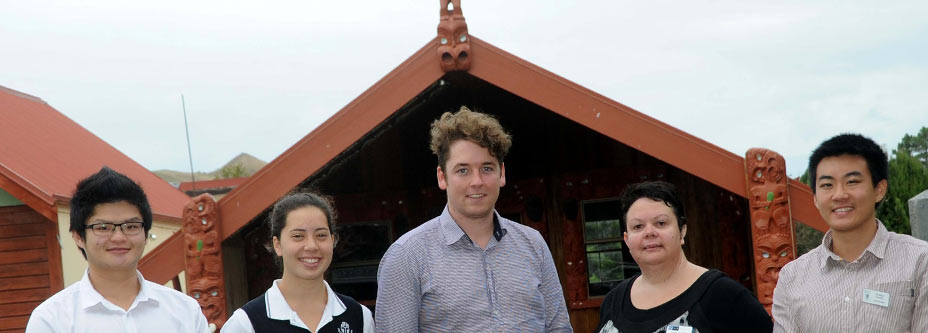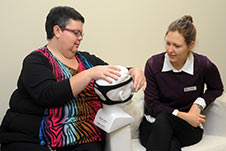
Working together, learning together
A new inter-professional health education programme for clinical students is breaking new ground.
For years, the University of Otago's clinical students have trained and learned their health disciplines in what have effectively been educational “silos”, not knowing a great deal about what other health professionals actually do until they start working in multidisciplinary health care.
Now things are changing, with a very different learning approach known as inter-professional education, or IPE. The University of Otago, Wellington has been hosting and organising this new programme within six different health disciplines, in collaboration with the Eastern Institute of Technology, in the Tairawhiti area around Gisborne.
It's funded by Health Workforce New Zealand in Tairawhiti, and in Whakatane under the auspices of the University of Auckland, at a cost of $2.5 million at each site over three years.
The aim is to assess how effective IPE is in training student health professionals to work together in clinical settings. This is especially so in the collaborative management of chronic conditions such as diabetes and asthma.
Director of the IPE programme, Associate Professor Sue Pullon (Department of Primary Health Care and General Practice, Wellington) says the first year has been challenging, but has progressed well, with positive learning outcomes.
“We had 27 students go through the programme in 2012, in three five-week blocks. They successfully lived, worked and studied together and, from the feedback we're getting, they've found it very rewarding, both professionally and personally.
“We also know from formal assessments that it's made a difference to their understanding and practice of interdisciplinary teamwork and to chronic-care management,” she says.
“They've learned a great deal about hauora Māori, or Māori health, as the population of Tairawhiti is 50 per cent Māori, and they've also experienced working in a rural environment, the first time for most. Other important aims are to encourage young health professionals to work in rural areas.”
After a successful first year, the Department of Primary Health Care and General Practice is now midway through running the second year of the IPE programme, with 60 students over five learning blocks.

Nursing student Samantha Cotton and Sophie Butto (dietetics) share information about their respective health disciplines at Tui Te Ora Clinic, Gisborne Hospital.
These students come from six disciplines: physiotherapy, pharmacy, medicine, nursing, dietetics and dentistry. Some, like pharmacist Wil Shen, have gone back to Gisborne Hospital this year for their intern year.
“I'm from Auckland and the IPE programme definitely made a big difference to my coming here this year. Most students don't really know what other health professionals do. A lot of my learning was informal, having conversations with other students about their work – that kind of thing.
“I also learnt a lot about other areas in more structured sessions; for instance, when we went to the physio gym and they put us through practical exercises. In Ruatoria I worked alongside medical students, observing what they did, and also went on a home visit to see a patient who wasn't taking his medication. All those experiences made a big difference to me as a pharmacist.”
Others, like physiotherapy student Solveig Martis, say her IPE experience was one of the highlights of her four-year course. “Overall I absolutely loved it. I would definitely recommend it to anyone, it was just wonderful. I had a really good five weeks.
“I learnt so much more, and it was great living and working with people from other disciplines. We shared ideas and information, both in class and informally, and then I could see what this all meant through the interdisciplinary placements. You get a much better appreciation of your strengths and limits in relation to the whole health team with our case presentations.”
Students also say it has given them a much better understanding of Māori health and the difficulties some Māori families may have in accessing health care.
Timaru house surgeon Dr Petronella Watson says: “Gisborne has a very strong and proud Māori culture and this was reflected in the IPE course. It was an honour to have the chance to spend some time in this community and I hope that it's not only enhanced my own practical perspective, but the whole group's.”
Pro-Vice Chancellor Health Sciences, Professor Peter Crampton, is optimistic about the new approach to the education of Otago's health professionals. However, he says these programmes are much more complex to deliver than students just going on a short clinical placement within their own discipline.
Crampton should know, for over a decade he was involved in the Wellington campus's hosting of medical students on the East Coast, with ongoing support from the Tairawhiti District Health Board, Ngati Porou and local Māori health providers.
“However, this is a very different approach to health education,” he explains. “I believe IPE programmes will become important for Otago's health science courses, but the evidence regarding the best way to achieve our objectives is still unfolding.
“It's easy to do IPE in a superficial way, but we have to be seen to add real value; that is to say, demonstrably improved results for our students.”
Crampton is adamant that one of the vital components of a successful IPE programme is for students to see qualified health professionals working together in an interdisciplinary way, managing chronic conditions such as diabetes or asthma.
There's no doubt that achieving these challenging educational outcomes in Tairawhiti is complex. It has relied on a local administrator, a programme leader and a team of professional practice fellows from all six disciplines, and a multi-centred Educational Operations Group overseeing the whole IPE programme.
It has also meant significant and vital support from staff of the Tairawhiti District Health Board, as well as Māori health providers in rural areas such as Tolaga Bay and Ruatoria.
Dr Patrick McHugh is the IPE programme leader in Tairawhiti, assisted by administrator Rose Parsons. “Our assessment is that it has gone well, although it has been a steep learning curve organising five or six different health disciplines in one programme,” he says.
“However, IPE has a lot going for it. It's recognised internationally that, if students are working in a team, they must be much more aware of the clinical skills and demands on their colleagues.”
McHugh says one of the more important aspects of the new programme is students undertaking projects on health issues, such as rheumatic fever, which are then presented to community health providers. This has been much appreciated by Māori health providers as recognition of their support in mentoring and assisting students.
The professional practice fellow for hauora Māori, Maaka Tibble, agrees and says these projects have focused understanding on the health needs of the Māori community and impressed health providers.
“The big thing is that students are seeing, face to face, the difficulties in things such as access to medical care in rural areas. We also run case studies that get them thinking about the Māori perspectives on health. It all adds up and has an impact on the future practice of these young people,” he says.
He hopes this new programme will also encourage more young New Zealanders to consider a career outside urban centres, helping to reduce health inequalities in rural areas.
AINSLIE TALBOT
